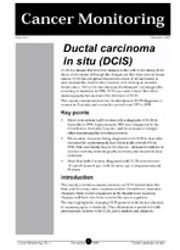Summary
DCIS is a disease that involves changes in the cells in the lining of the ducts of the breast. Although the changes are like those seen in breast cancer, DCIS has not spread beyond the ducts. If left untreated, it may increase the chances that a woman will develop an invasive breast cancer. Before the introduction of nationwide mammographic screening in Australia in 1991, DCIS was rarely found. Since then mammography has increased the detection of DCIS. This report presents statistics for the first time on DCIS diagnoses in women in Australia and covers the period from 1993 to 1998.
Key points
- There were almost 1,200 women with a diagnosis of DCIS in Australia in 1998. Approximately 58% were diagnosed by the BreastScreen Australia Program, and the remainder through other mammography screening services.
- The number of women being diagnosed with DCIS in Australia increased by approximately two-thirds in the period 1993 to 1998. This was mainly due to two factors—increased numbers of women receiving mammography screening and improved data collection.
- More than half of women diagnosed with DCIS were between 50 and 69 years of age, with the mean age at diagnosis around 59 years.
Key points
Introduction
BreastScreen Australia program
What is DCIS?
Numbers of new cases and rates of DCIS in cancer registry data
Numbers of new cases and rates of DCIS in BreastScreen Australia program data
Numbers of new cases and rates of DCIS in States and Territories
Annual numbers and rates of DCIS in States and Territories
End matter: References



